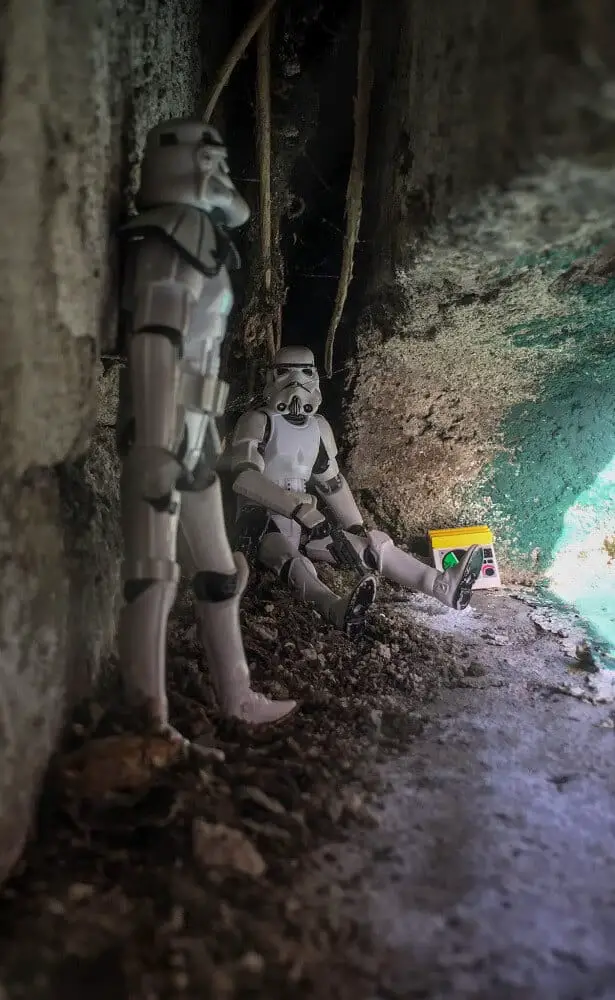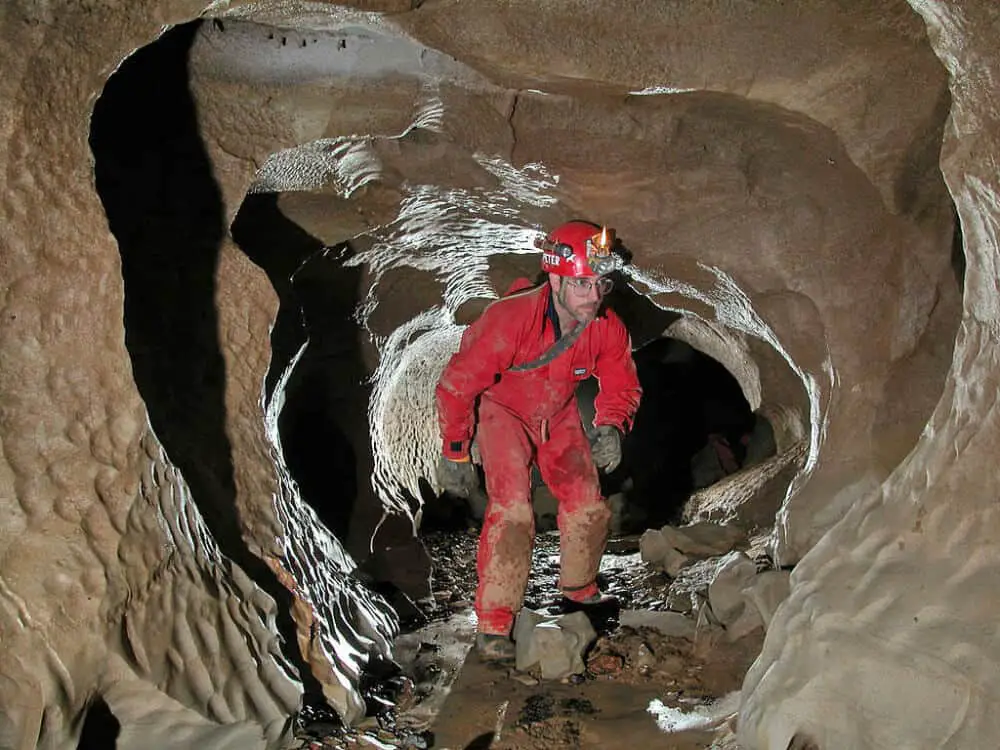When I went on my first caving trip a couple of months ago, I had no clue what to wear. If you’re clueless as well, this is the right post for you.
What to wear caving? You need to wear a good quality helmet, a good headlamp (and bring at least two backup lights), a coverall or caving suit, protective gear (knee pads, elbow pads, gloves), the right underwear (polypro), and good caving boots. Most cavers also bring a caving backpack with some essential tools (compass, first aid kit).
The list somewhat differs for first-time cavers and serious cave explorers. So I’ve made two lists: one for people that regard themselves as cavers, and one for your first caving trip.
What Committed Cavers Wear
I’ve compiled a complete caving gear list, after making some rookie mistakes (I wore heavy cotton the first time round, which seemed to find and collect all available cold water, making for a fun first experience).
If your nickname is ‘the mole’, you’re wearing:
- A solid helmet (for help picking one, check my buyer’s guide)
- A good headlamp + two spares – this is by far the best headlamp on a budget (click to check on Amazon) – Don’t go underground without at least three independent light sources.
- Coverall or caving suit
- Polypro long underwear – the only right underwear for cavers
- Undersuit
- Gloves
- Protective pads – I like these DeWalt Kneepads best (click to check on Amazon)
- Waterproof backpack
- Good hiking boots – I prefer these
- Good quality socks – preferably wool or neoprene hiking socks
In your backpack you’ll preferably carry:
- 2 spare lamps / flashlights
- Spare batteries or battery packs – to provide light for at least twice your trip length
- A 6-hour candle + waterproof matches (for emergencies)
Optionally you also carry:
- A map of the cave
- Compass
- Duct tape
- Zip-lock bags
- Pocket knife / multi-tool
- Watch
- First Aid Kit
- Water-sealed spare clothes (very light weight)
In your car, you keep:
- Dry clothes to change into afterward
- Garbage bags (for dirty clothing)
- A towel
- Extra food and water
- Toilet paper
- GPS or navigation
If you’re planning to do cave mapping you need to bring two or three extra things. If you want to know exactly what to bring I recommend reading my article on cave mapping gear (opens a new tab).
What To Wear On Your First Caving Trip
For most novice caving trips you won’t need to bring the entire inventory. Most of the time, beginner’s trips don’t involve (a lot of) squeezes, climbing, diving, and other uncomfortable activities. Plan on mostly hiking, some traversing, and some bouldering.
Mostly you need to get your hands on a helmet that fits and a good headlamp. My guess is these are the two only items you’ll need to rent or borrow. So your gear list looks more like this:
- A solid helmet
- A good, reliable headlamp
- Old clothes – make sure they’re lightweight but warm, preferably synthetic fiber
- Coverall or old raining suit as top layer will do fine
- Solid undergarments and good quality socks
- Optionally some protective wear such as gloves (you can use workers gloves) and knee pads
- Shoes with closed toes and a rubber sole with a decent grip (construction or hiking boots)
- A spare flash light and plenty of spare batteries (you want to bring enough for at least twice your trip length)
If you want to know more about what to expect from caving, I’ve written a comprehensive beginner’s guide.
What Clothing Depends On Your Caving Style
What type of gear you need all comes down to your caving style. If you’re more of a recreational cave-wanderer, there’s no need to go full Stormtrooper. Just make sure you wear clothes with long sleeves that won’t rip easily. However, wearing a helmet with a headlamp is non-negotiable.
If on the other hand, you like to do a lot of squeezes, you should definitely consider investing in good-quality protective gear, such as knee pads, elbow pads, and durable gloves.
If you climb a lot, you should consider buying specialized climbing gear for cavers. Do not use regular climbing gear! It’s not suitable for the conditions and stresses of caving and is likely to fail on you in crucial moments.
The Gear Depends On Your Caving Location
Clothing and gear greatly vary depending on the location of the cave, and the type of cave. In the UK, most of the caves are wet caves, which means it’s humid and cold. You might want to wear an additional layer of clothing and choose a special water-resistant fabric.
If you’re exploring Kentucky caves, it’s an entirely different story. Temperatures are higher and the air humidity is lower. In these caves, you might want to wear fewer clothes.
Caving Gear Should Be Tough
Caving is a very harsh sport, and it will put your equipment to the test. In my short time (a couple of months), I’ve already destroyed a headlamp, a pair of gloves (weren’t supposed to be used for anything but biking I guess), and a pair of jeans. So it’s definitely worthwhile to invest in high-quality gear. Also, pay attention to the warranty period, since some companies really try to help you out with lifetime no-questions-asked warranties.
What Features You Should Look For In Caving Clothing
- Caving clothes should be lightweight – Since you’ll be on your feet and moving constantly, weight should be reduced as much as possible. Any extra weight will eventually wear you down.
- Caving clothes are warm and dry – They should keep you reasonably dry and warm in cold, humid conditions. This is an important barrier in preventing Hypothermia.
- The right material – Synthetic fabrics are the best, since it will stay warm when wet, and doesn’t add a lot of weight. Avoid cotton (except for the outermost layer).
- Durability – Caving clothes should be durable.
A Caving Outfit Consists Of Three Layers
- Polypro long underwear
- Synthetic middle wear
- Coverall to protect from dirt and water
Polypropene long underwear really adds a lot of comfort to your caving trip. It helps to keep you both warm and dry. If it gets wet, it stays warm as well.
For your middleware, you should use durable materials that insulate, without adding a lot of weight. Preferably loose, synthetic clothes, such as gym clothes.
Specialized coveralls are made from a cotton or poly blend. For your upper layer, choose a specialized caving coverall.
The Importance Of A Good Headlamp
Light is your number one resource when underground. Without it, you’re completely lost, since your eyes won’t get used to the dark over time (there just isn’t any light there). So you need good and reliable light sources.
If you’re planning to buy a main headlamp or a spare flashlight and want to know what to look for in a reliable light source, I definitely recommend to check out my post on headlamps.
Rent Or Borrow Gear Before Committing
Is it your first time caving? I always try to rent or borrow the gear first. This way I can get familiar with a new hobby before committing to buying the stuff. In my mind, this makes sense, and it has saved me from buying some very expensive items in the past (for example a longbow).
With most beginner caves, there’s a local tourism office, which rents out hard hats and lamps at low prices. You can also check with your local grotto.
If you’re not that type of guy or girl, and you want to purchase all necessary gear straight away: that’s fine. But at least check out our budget buyer’s guide, to make sure you buy it right first time.

Related Questions
Where can I go caving? Most cavers try to find known or unknown caves by themselves. This requires skill and knowledge. To be successful at cave exploration, and for safety reasons, they form groups, which are called ‘grottos’. If you want to learn about the caves in your area, maybe consider joining your local grotto.
Is caving dangerous? Caving can be dangerous, due to the hazard of falling rocks, hypothermia, getting lost and isolation, and especially falling, which is the number one cause of injury among cavers. In some caves, you even risk drowning. But, when properly prepared and trained, it doesn’t have to be dangerous.
If you want to know more about the dangers of caving, please read my article. It’s good: I’ve done actual factual research.

